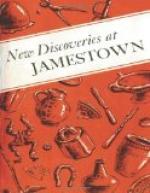All currycombs found are handwrought, and many have pleasing designs on the backs, formed by the curved iron strips which extend from the handle prong to the back of the comb.
Branding Irons.—Parts of several branding irons were found including a complete example with initials “TR.”
Wagon and Carriage Parts.—Archeologists unearthed only a few metal parts from wagons and carriages—reminders of a day when horses and oxen were indispensable animals in the Virginia settlements.
Trade
Some interesting objects recovered at Jamestown relate to early trade. These include items used in trade with the Indians, as well as an excellent assortment of lead bale clips. These clips are decorated discs which were often attached to bales of goods (especially woolen cloth) imported from England. One object, the heaviest unearthed at Jamestown, relates indirectly to trade. It is a 1,300-pound iron piledriver which was once used to build wharfs and piers.
INDIAN TRADE
One reason why the colonists selected a site for Jamestown some miles up the James River was to develop the Indian trade over an extensive area. During the early years of the colony, trade with the natives was encouraged. It is clear from the early records that the settlers bartered such items as beads, cloth, penny knives, shears, bells, glass toys, whistles, hatchets, pots and pans, brass casting counters, and similar objects in exchange for Indian corn (and other vegetables), fish, game, fruits and berries, and furs.
Many examples of English trade goods used for bartering with the Indians have been found on the island, but these can be described only briefly.
Beads.—The majority of glass beads were shipped from England, although some may have been made in Italy, probably in Venice. As no glass beads were found at or near the site of the glass factory, it is doubtful whether any were made there. Most beads in the collection are round or oval, a few are cylindrical having been cut from colored glass rods. All beads excavated are of one or more colors, with the exception of 2 or 3 that are colorless. After three centuries the attractive colors still persist; and looking at the colorful beads today you can understand the charm they held for the Indians.
Knives.—Small, inexpensive knives called penny knives, were often used for trading purposes during the years at Jamestown. A few folding knives and blade fragments (which may also have been penny knives) have been recovered.
Shears.—Several shears and scissors, highly prized by the Indians, were found on the island. A few are almost complete.
Bells.—Brass and iron bells of types which were used for bartering with the Indians have been excavated. A few days after the colonists reached Jamestown one of them recorded that “our captaine ... presented [to an Indian chief] gyftes of dyvers sortes, as penny knyves, sheeres, belles, beades, glass toyes &c. more amply then before.”




